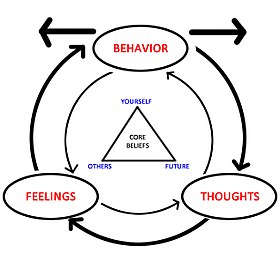Using CBT for Panic Disorder Treatment
by Vlasta Kuster
CBT for panic disorder is a highly effective treatment and it lasts about 12 sessions.
Some people respond more quickly and need even less sessions, while others can even need more time to achieve some improvement.
Cognitive-Behavioral Therapy (CBT ) is a type of psychotherapy which is used to treat different mental health conditions, .based on the fact, that individual’s thoughts, feelings or perceptions influence on his/her actions and behaviors.
The diagram depicts how emotions, thoughts, and behaviors all influence each other according to CBT. The triangle in the middle represents CBT's tenet that all humans' core beliefs can be summed up in three categories: self, others, future.
Source : Wikipedia - CBT
The fact is that people who suffer from panic disorder are often more susceptible to negative thoughts and self-defeating beliefs.
Consequently, they are faced with a low self-esteem and increased anxiety.
The purpose of the CBT for panic disorder treatment is to help people to overcome negative thinking patterns in order to help them to make better decisions concerning their actions and behaviors.
The fact is that a person may not always be able to change its own life circumstances.
However he/she always has a possibility to choose how to perceive and acts upon life’s ups and downs.
CBT is based firmly on research findings and it helps a person in achieving specific changes or goals.
For example:
- a way of acting (being more outgoing),
- a way of feeling (helping a person to be less scared, anxious or depressed),
- a way of thinking (learning to problem-solve) and
- a way of dealing with physical or medical problems (helping a person stick to a doctor’s suggestions).
Typical symptoms (usually there is a mix of physical and cognitive symptoms). which an individual experiences while suffering from a panic attack are for example
- chest pain,
- heart palpitations,
- shortness of breath.
They are perceived as frightening and can lead to distressing thoughts, like fear of losing control or dying.
The problems begin when fears experienced during a panic attack become very strong and they can have a negative influence on a person’s behaviors.A person can develop (thoughts) a fear of having an attack while being in a crowed place.
As a result, that person will try to avoid crowded areas in the future.Such behaviors lead to another condition called agoraphobia.
Further in the article we are going to list 6 steps that are followed in the CBT for panic treatment, CBT for panic disorder treatment is also usually combined. by some interventions, such as those explained here.
1. Recognizing and Replacing Negative Thoughts
It is important to identify our negative cognitions or thinking patterns, contemplate how we perceive ourselves, how we interpret the world around us or how we feel during a panic attack.
This is the way to recognize our thought process, typical thought patterns and the impact that it has to our behaviors.
2. Activities and Different Exercises
There are lot of activities, different exercises and even a homework activity that an individual has to accomplish in order to become aware of his negative thoughts and to learn to replace them with other healthier ways of thinking or even to eliminate faulty thinking.
3. Why is Writing also a part of CBT for Panic Disorder Treatment ?
Writing exercises that include journal writing, keeping a gratitude journal and maintaining a panic diary are a good way to increase awareness of or to replace the negative thoughts
4. Skill Building and Behavioral Changes
The fourth step of CBT is compounded by building healthy coping strategies.
The goal of these strategies is to change maladaptive behaviors of a person who learns to develop certain skills.
These skills help him/her to
- reduce stress,
- manage anxiety and
- how to go through panic attacks
5. Desensitization
Desensitization is a CBT technique that helps a person to get past avoidance behaviors.
During the treatment an individual gets introduced to anxiety-producing stimuli. He or she is then thought to learn skills on how to deal with the feelings of anxiety in order to cope with panic symptoms through feared circumstance or places.
6. Learning Relaxation Techniques
With a purpose to stay calm during an anxiety-provoking circumstances, a person learns different relaxation techniques such as
- deep
breathing exercises,
- progressive muscle relaxation,
- meditation and
- yoga
They help to manage fear, lowering the heart rate, to reduce the tension and to improve problem-solving skills.
You might like these
5 CBT Panic Disorder Interventions
There are 5 CBT panic disorder interventions (CBT stands for Cognitive Behavioral Treatment) with which the cognitive behavioral treatment for panic disorder is usually combined.
Sources:
https://www.verywellmind.com/cognitive-behavioral-therapy-2584290
http://cogbtherapy.com/cbt-for-panic-attacks
https://www.ncbi.nlm.nih.gov/pmc/articles/PMC2755166/
http://www.abct.org/Information/?m=mInformation&fa=fs_PANIC


